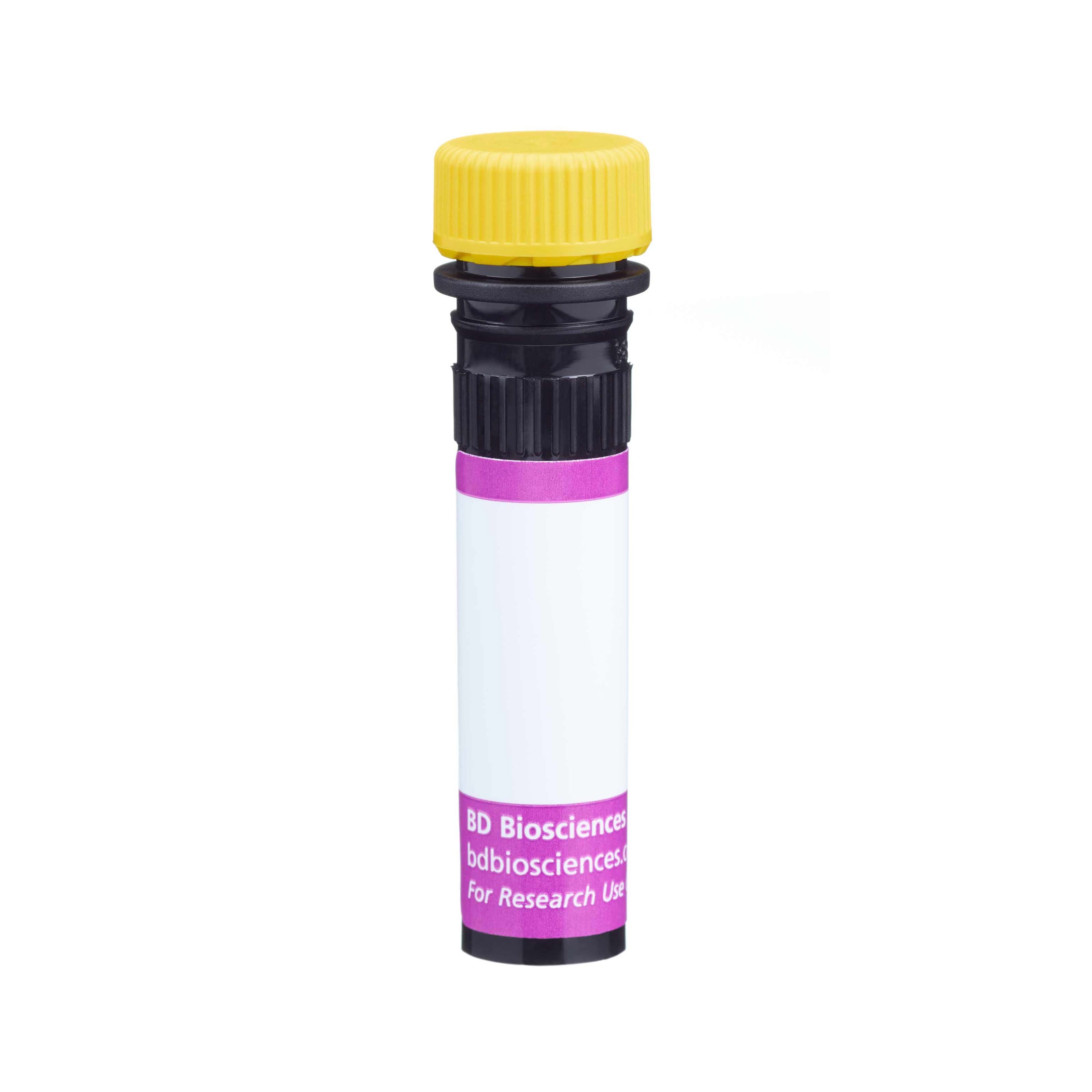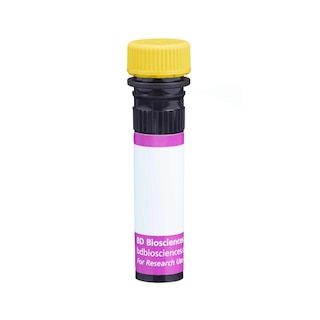Old Browser
Looks like you're visiting us from {countryName}.
Would you like to stay on the current country site or be switched to your country?


Regulatory Status Legend
Any use of products other than the permitted use without the express written authorization of Becton, Dickinson and Company is strictly prohibited.
Preparation And Storage
Recommended Assay Procedures
For optimal and reproducible results, BD Horizon Brilliant Stain Buffer should be used anytime two or more BD Horizon Brilliant dyes (including BD OptiBuild Brilliant reagents) are used in the same experiment. Fluorescent dye interactions may cause staining artifacts which may affect data interpretation. The BD Horizon Brilliant Stain Buffer was designed to minimize these interactions. More information can be found in the Technical Data Sheet of the BD Horizon Brilliant Stain Buffer (Cat. No. 563794).
Product Notices
- This antibody was developed for use in flow cytometry.
- The production process underwent stringent testing and validation to assure that it generates a high-quality conjugate with consistent performance and specific binding activity. However, verification testing has not been performed on all conjugate lots.
- Researchers should determine the optimal concentration of this reagent for their individual applications.
- An isotype control should be used at the same concentration as the antibody of interest.
- Caution: Sodium azide yields highly toxic hydrazoic acid under acidic conditions. Dilute azide compounds in running water before discarding to avoid accumulation of potentially explosive deposits in plumbing.
- For fluorochrome spectra and suitable instrument settings, please refer to our Multicolor Flow Cytometry web page at www.bdbiosciences.com/colors.
- Please refer to www.bdbiosciences.com/us/s/resources for technical protocols.
- BD Horizon Brilliant Stain Buffer is covered by one or more of the following US patents: 8,110,673; 8,158,444; 8,575,303; 8,354,239.
- BD Horizon Brilliant Violet 650 is covered by one or more of the following US patents: 8,110,673; 8,158,444; 8,227,187; 8,455,613; 8,575,303; 8,354,239.
- Alexa Fluor® is a registered trademark of Life Technologies Corporation.
Companion Products






The mCD30.1 monoclonal antibody specifically recognizes CD30. CD30 is also known as Tumor necrosis factor receptor superfamily, member 8 (Tnfrsf8). The CD30 molecule is predominantly expressed by activated T lymphocytes, with its expression peaking at day 4-5 on spleen cells activated with plate-bound anti-CD3e antibody. The mCD30.1 antibody reacts with a majority of CD8+ T cells, as well as some CD4+ T cells in these cultures. Expression of CD30 on activated T lymphocytes is regulated by CD28 and cytokines. Its TNF-superfamily ligand, CD30L or CD153, is also expressed on activated T lymphocytes. By northern blot analysis, mouse Cd30 mRNA is detected in the thymus and in 72-hour pokeweed mitogen- and Con A-activated spleen cells, but not in the lung, brain, kidney, liver, bone marrow, unactivated spleen, or 72-hour LPS-activated splenocytes.1 It has also been reported that CD30 is expressed on naive B lymphocytes, it is not detectable after activation, and it starts to return after 72 hours following activation. Reports suggest that signaling through the CD30 molecule may be important in cytokine production by CD8+ CTL lines and may play a role in the regulation of Th1 and Th2 cytokine secretion by CD4+ and CD8+ T cells. It has also been proposed that CD30 plays an important role in the negative selection of thymocytes and protects against autoimmunity. Members of the TNFR family and their ligands are involved in the induction of diverse biological responses in lymphocytes, including differentiation, proliferation, and cellular death. In humans, CD30 was initially identified in Hodgkin and Reed-Sternberg cells in Hodgkin's disease patients and subsequently was found on neoplastic cells of certain types of non-Hodgkin's lymphomas.
The antibody was conjugated to BD Horizon™ BV650 which is part of the BD Horizon Brilliant™ Violet family of dyes. This dye is a tandem fluorochrome of BD Horizon BV421 with an Ex Max of 405-nm and an acceptor dye with an Em Max at 650-nm. BD Horizon BV650 can be excited by the violet laser and detected in a filter used to detect APC-like dyes (eg, 660/20-nm filter). Due to the excitation and emission characteristics of the acceptor dye, there will be spillover into the APC and Alexa Fluor® 700 detectors. However, the spillover can be corrected through compensation as with any other dye combination.

Development References (12)
-
Amakawa R, Hakem A, Kundig TM, et al. Impaired negative selection of T cells in Hodgkin's disease antigen CD30-deficient mice. Cell. 1996; 84(4):551-562. (Biology). View Reference
-
Bowen MA, Lee RK, Miragliotta G, Nam SY, Podack ER. Structure and expression of murine CD30 and its role in cytokine production. J Immunol. 1996; 156(2):442-449. (Immunogen). View Reference
-
Chiarle R, Podda A, Prolla G, Podack ER, Thorbecke GJ, Inghirami G. CD30 overexpression enhances negative selection in the thymus and mediates programmed cell death via a Bcl-2-sensitive pathway. J Immunol. 1999; 163(1):194-205. (Biology). View Reference
-
Cosman D. A family of ligands for the TNF receptor superfamily. Stem Cells. 1994; 12(5):440-455. (Biology). View Reference
-
DeYoung AL, Duramad O, Winoto A. The TNF receptor family member CD30 is not essential for negative selection. J Immunol. 2000; 165(11):6170-6173. (Biology). View Reference
-
Falini B, Pileri S, Pizzolo G, et al. CD30 (Ki-1) molecule: a new cytokine receptor of the tumor necrosis factor receptor superfamily as a tool for diagnosis and immunotherapy. Blood. 1995; 85(1):1-14. (Biology). View Reference
-
Gilfillan MC, Noel PJ, Podack ER, Reiner SL, Thompson CB. Expression of the costimulatory receptor CD30 is regulated by both CD28 and cytokines. J Immunol. 1998; 160(5):2180-2187. (Biology). View Reference
-
Heath WR, Kurts C, Caminschi I, Carbone FR, Miller JF. CD30 prevents T-cell responses to non-lymphoid tissues. Immunol Rev. 1999; 169:23-29. (Biology). View Reference
-
Nakamura T, Lee RK, Nam SY, et al. Reciprocal regulation of CD30 expression on CD4+ T cells by IL-4 and IFN-gamma. J Immunol. 1997; 158(5):2090-2098. (Biology). View Reference
-
Shanebeck KD, Maliszewski CR, Kennedy MK, et al. Regulation of murine B cell growth and differentiation by CD30 ligand. Eur J Immunol. 1995; 25(8):2147-2153. (Biology). View Reference
-
Shimozato O, Takeda K, Yagita H, Okumura K. Expression of CD30 ligand (CD153) on murine activated T cells. Biochem Biophys Res Commun. 1999; 256(3):519-526. (Biology). View Reference
-
Siegmund T, Armitage N, Wicker LS, Peterson LB, Todd JA, Lyons PA. Analysis of the mouse CD30 gene: a candidate for the NOD mouse type 1 diabetes locus Idd9.2. Diabetes. 2000; 49(9):1612-1616. (Biology). View Reference
Please refer to Support Documents for Quality Certificates
Global - Refer to manufacturer's instructions for use and related User Manuals and Technical data sheets before using this products as described
Comparisons, where applicable, are made against older BD Technology, manual methods or are general performance claims. Comparisons are not made against non-BD technologies, unless otherwise noted.
For Research Use Only. Not for use in diagnostic or therapeutic procedures.
Refer to manufacturer's instructions for use and related User Manuals and Technical Data Sheets before using this product as described.
Comparisons, where applicable, are made against older BD technology, manual methods or are general performance claims. Comparisons are not made against non-BD technologies, unless otherwise noted.
Report a Site Issue
This form is intended to help us improve our website experience. For other support, please visit our Contact Us page.